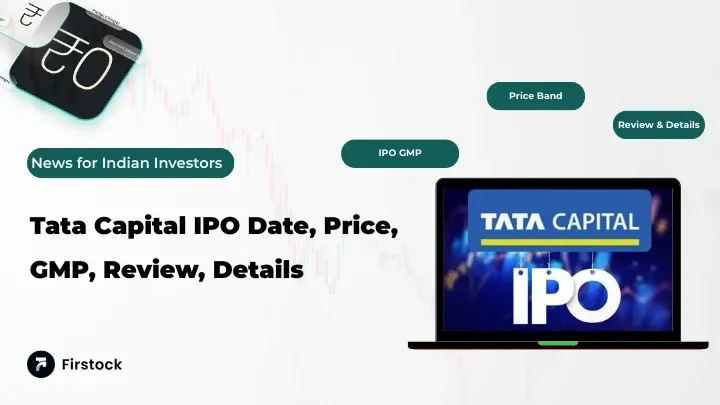Tata Capital IPO GMP 2025 | Latest Price & Listing Details

Tata Capital IPO GMP, Date, Price, Review, Details
The Tata Capital IPO is shaping up to be one of the biggest public offerings in India’s financial sector in 2025. With the backing of the Tata Group, it draws attention not just for scale but also for its role in NBFC regulation, valuation expectations, and equity market sentiment. In this article, we’ll cover Tata Capital IPO GMP, Date, Price, Review, Details, along with shareholding structure, grey market, strengths & risks, and FAQs.
The upcoming tata capital ipo is significant for several reasons. First, it stems from regulatory changes introduced by the Reserve Bank of India. Under the RBI’s “upper layer” NBFC framework, large institutions such as Tata Capital must list their shares on the stock exchanges within a stipulated time frame. By going public, Tata Capital aligns with this mandate, while also unlocking a fresh source of capital to fund its lending activities.
But there is also a larger narrative. For years, market observers have speculated about when the Tata Group would bring its financial services arm to the bourses. The wait is finally over, and this listing carries symbolic weight: it signals the Group’s intention to make its NBFC business more transparent and accountable to public shareholders. Analysts tracking the BFSI sector believe this IPO will be among the most closely watched of 2025.
This blog provides an overall summary of the Tata Capital IPO, which includes the overall background of the Company, history, operations, financial strength, regulatory background, Issue structure, market reception, and risks.
Company Snapshot & Why the IPO Matters
Tata Capital launched in 2007 to be the financial services arm of Tata Group. Over the years, Tata Capital has grown into a full service NBFC providing a wide array of services:
The IPO isn’t just a capitalization event—it’s also driven by regulatory needs. The Reserve Bank of India (RBI) mandates that large NBFCs classified as “upper-layer” list on stock exchanges within a given timeline. Tata Capital had been required to list in the first half of October.
The listing will make Tata Capital’s performance more transparent to public investors and may strengthen its capital base for further lending expansion.
Key IPO Details: Date, Structure & Pricing
Here’s what is publicly known so far:
>IPO Dates: Opens October 6, 2025; closes October 8, 2025 for public subscription. Anchor investor bids begin October 3.
>Price Band: ₹310 to ₹326 per equity share, face value ₹10.
>Issue Size / Share Count:
- Fresh issue: ~21 crore shares
- Offer for Sale (OFS): ~26.58 crore shares by existing shareholders (Tata Sons, IFC)
- Total shares offered: ~47.58 crore shares
>Valuation Target: The post-money valuation target is around USD 16.5 billion (approx. ~₹1,46,000 crore) for the combined issue.
>Regulatory Filings: The Draft Red Herring Prospectus (DRHP / UDRHP) is filed under SEBI’s public issues section. Securities and Exchange Board of India
>RBI Extension: Because the listing deadline was approaching, RBI granted an extension to Tata Capital to list in the first half of October.
In sum, this is a mixed issue (fresh + OFS) with aggressive valuation expectations and regulatory underpinnings.
Grey Market Premium (GMP) & Early Market Sentiment
Even before the IPO listing, the Tata Capital IPO GMP has been active in the unlisted (grey) market:
>The reported grey premium is around ₹28 over the expected issue price as of 29th sep 2025 01:53pm.
>Because the price band is already defined, the absolute premium will be determined once final allotments happen.
>Grey market action gives a sentiment signal—indicates investor appetite and confidence ahead of listing.
However, GMP is not guaranteed or binding. It can fluctuate widely based on demand, allocation, and market conditions.
Shareholding & Quota Structure
Understanding tata capital ipo shareholder quota is important:
>Reserved shares for Retail Investors: ~35% of the issue (standard practice in large IPOs)
>Qualified Institutional Buyers (QIB): ~50% portion of the issue
>Non-Institutional Investors (NII): ~15% quota
>Employee Quota: A small reservation for company employees (exact share count is 0.25% or 12,00,000)
>Promoter holdings: Pre-IPO 95.6% — Post-IPO 85.5%
>This balance aims to give retail investors a meaningful share while leveraging institutional participation.
Use of Proceeds & Strategic Goals
Funds raised from tata capital ipo are earmarked for:
- Strengthening Tier-1 Capital: To meet regulatory capital norms and improve lending capacity.
- Business Growth & Lending Expansion: Particularly in high-potential verticals.
- Regulatory Compliance & Capital Adequacy: RBI’s listing mandate for upper-layer NBFCs is one driver.
These uses reflect both the opportunity and the obligation behind this IPO.
Strengths, Opportunities & Risks: A Balanced View
Strengths / Positives
>Brand backing: Tata Group name brings trust and credibility.
>Diversified operations: Already serving across finance, lending, wealth management.
>Regulatory alignment: IPO is in part driven by RBI listing mandate, offering structural justification.
>Strong investor interest: GMP, media buzz, and large issue size point to high demand.
Risks / Challenges
>Valuation pressure: Given discount vs unlisted price and high expectations, upside is partially constrained.
>Execution risk: Deploying capital efficiently while maintaining credit quality is crucial.
>Macro / interest rate sensitivity: NBFCs’ margins are sensitive to interest rate changes and credit cycles.
>Grey market overhype: GMP might overshoot or misrepresent fundamentals.
>Competition and asset quality: The NBFC lending space is crowded; non-performing assets (NPAs) remain a risk.
A prudent review must weigh both the upside and the structural risks.
Market Context & Sector Outlook
Tata Capital’s IPO also fits into a broader BFSI (Banking, Financial Services & Insurance) IPO push in 2025:
>The sector is seeing a wave of offerings, targeting ₹58,000 crore in new issues.
>Tata Capital’s size makes it one of the marquee issues in this wave.
>Investor appetite for financial NBFCs is strong, given reforms, credit growth expectations, and interest rate outlook.
The success of this IPO may set the tone for upcoming deals in the financial sector.
Conclusion
The Tata Capital IPO GMP, Date, Price, Review, Details showcase one of the most awaited IPOs of 2025. With its scale, regulatory significance, and brand reputation, Tata Capital’s public issue is expected to draw considerable participation across investor classes. While the GMP highlights strong initial demand, market watchers will closely monitor subscription levels and final listing performance.
FAQs
1: What is Tata Capital IPO GMP (Grey Market Premium)?
GMP is the premium at which shares trade informally before listing. For Tata Capital, it’s reported to be around ₹28 as of 29th Sep 2025 01:53pm.
2: When is the Tata Capital IPO date?
Public subscription opens on October 6, 2025, and ends on October 8, 2025. Anchor bidding begins October 3.
3: What is the Tata Capital IPO price band?
The shares are priced between ₹310 and ₹326 each.
4: What is the Tata Capital IPO shareholder quota / allocation?
Retail investors get ~35%. QIB gets ~50%. NII ~15%.Employee quota 0.25%.
5: What is Tata Capital?
It is the financial services arm of Tata Group, involved in lending, wealth management, housing finance, and more.
6: How many shares are in the Tata Capital IPO?
Approx. 47.58 crore shares total – fresh issue of ~21 crore + OFS of ~26.58 crore.
7: What is the valuation for Tata Capital IPO?
Post-money valuation is being targeted around USD 16.5 billion (~₹1,46,000 crore).





